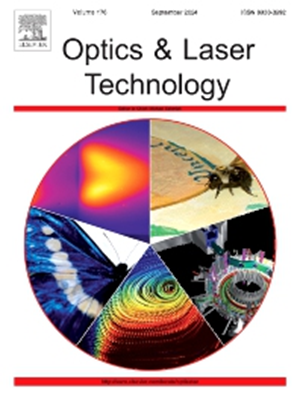Study of convexity on nanosecond laser-induced damage growth in fused silica
IF 4.6
2区 物理与天体物理
Q1 OPTICS
引用次数: 0
Abstract
Damage growth in fused silica under ultraviolet nanosecond laser irradiation poses a significant threat to the stable operation of high-power laser systems and shortens the service life of optical components. In this study, an experimental scheme was developed in which initial damage sites were deliberately fabricated and subsequently subjected to medium-aperture laser irradiation to induce further growth. A time-resolved shadowgraph imaging system was designed to capture the dynamic evolution of damage morphology and polarization characteristics. Statistical analysis of the final damage images—acquired from both transmission-view and side-view microscopic imaging systems—revealed that the damage morphology, particularly the structure of radial cracks, plays a key role in determining the damage growth coefficient. To quantitatively characterize the morphology of radial cracks, a novel morphological parameter, convexity, was introduced. The analysis showed that damage sites with lower convexity generally exhibited higher growth coefficients and shallower damage depths. These findings provide valuable theoretical insights for the prediction and mitigation of laser-induced damage and establish a foundation for the further refinement of damage growth models.
熔融二氧化硅纳秒激光损伤生长的凹凸性研究
在紫外纳秒激光照射下,熔融石英中的损伤生长严重威胁到高功率激光系统的稳定运行,缩短了光学元件的使用寿命。在本研究中,开发了一种实验方案,其中故意制造初始损伤部位,随后进行中孔径激光照射以诱导进一步生长。设计了一种时间分辨阴影成像系统来捕捉损伤形态和极化特征的动态演变。从透射视图和侧面显微成像系统获得的最终损伤图像的统计分析表明,损伤形态,特别是径向裂纹的结构,在决定损伤增长系数方面起着关键作用。为了定量表征径向裂纹的形态,引入了一个新的形态参数——凸度。分析表明,凹凸度越低的损伤部位生长系数越高,损伤深度越浅。这些发现为激光损伤的预测和缓解提供了有价值的理论见解,并为进一步完善损伤增长模型奠定了基础。
本文章由计算机程序翻译,如有差异,请以英文原文为准。
求助全文
约1分钟内获得全文
求助全文
来源期刊
CiteScore
8.50
自引率
10.00%
发文量
1060
审稿时长
3.4 months
期刊介绍:
Optics & Laser Technology aims to provide a vehicle for the publication of a broad range of high quality research and review papers in those fields of scientific and engineering research appertaining to the development and application of the technology of optics and lasers. Papers describing original work in these areas are submitted to rigorous refereeing prior to acceptance for publication.
The scope of Optics & Laser Technology encompasses, but is not restricted to, the following areas:
•development in all types of lasers
•developments in optoelectronic devices and photonics
•developments in new photonics and optical concepts
•developments in conventional optics, optical instruments and components
•techniques of optical metrology, including interferometry and optical fibre sensors
•LIDAR and other non-contact optical measurement techniques, including optical methods in heat and fluid flow
•applications of lasers to materials processing, optical NDT display (including holography) and optical communication
•research and development in the field of laser safety including studies of hazards resulting from the applications of lasers (laser safety, hazards of laser fume)
•developments in optical computing and optical information processing
•developments in new optical materials
•developments in new optical characterization methods and techniques
•developments in quantum optics
•developments in light assisted micro and nanofabrication methods and techniques
•developments in nanophotonics and biophotonics
•developments in imaging processing and systems

 求助内容:
求助内容: 应助结果提醒方式:
应助结果提醒方式:


